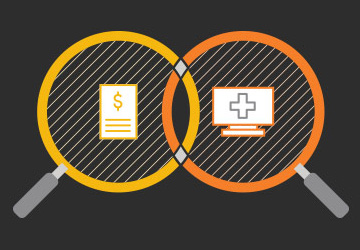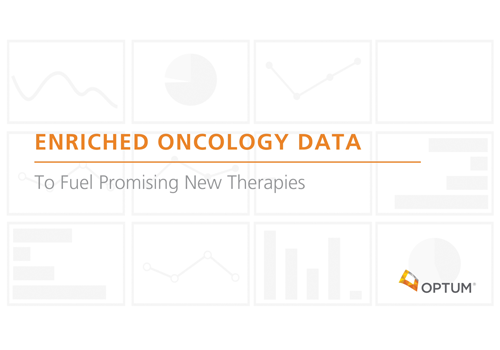The four fundamental questions in health care
Anyone who has had the privilege of working with all major stakeholders in the health care ecosystem (payer, provider, patient, life sciences) can likely attest that we are asking the same fundamental questions.
We may couch our questions in slightly different words and evaluate them from different perspectives, but looking closely at their essence, they generally boil down to one of these four. Equally interesting is that a few key types of real-world data (RWD) have the potential to answer most all of them.
Who is the patient?
"Who is the patient" speaks to the patient finding exercise.
Identifying a patient who fits specific criteria is a foundation for clinical trial recruitment. Who is the patient that has BRCA1, HER2 positive, ER/PR negative, Stage III breast cancer?
Population health management uses patient finding to identify patients who need a mammogram, vaccinations, smoking cessation programs and other interventions.
Providers ask, “Who is the patient that a given therapy will benefit?”
Payers conduct patient finding in their clinical and adherence programs.
What is the risk?
Here, we are referring to the group of questions surrounding a patient's or group of patients’ likelihood for experiencing a specific clinical outcome, such as the risk of hospital readmission, risk of bleeding and risk of sepsis, to name a few.
Payers have historically engaged in risk estimation and risk stratification whether for underwriting, participating in CMS contracts, population health or clinical programming.
Providers have used clinical risk stratification tools to design patient care plans, make therapeutic decisions and improve a patient's engagement in their own health. As the understanding of the risk factors for developing of chronic diseases improves, patients are also asking themselves, “Am I at risk for Alzheimer’s disease, cancer or diabetes?”
Life sciences has long used risk estimation to quantify unmet medical needs to payers and employers accompanied by the role their intervention may play in risk reduction.
What is the cost?
The question “what is the cost?” comes in many forms. What is the total cost of care for patients with a given disease or group of comorbidities? What are the biggest drivers of cost in a given disease? What subgroups of patients cost a health plan the most? What is the cost of a given therapy, diagnostic or procedure?
On the other side of the cost equation is value. Does spending more on a given intervention come with reduced care costs? When we implement a new care process, does the overall cost of caring for the patient go down? What are the items that should be included in defining an episode of care for bundled payments?
Which intervention is better?
The question of which one is better can be translated into the common phrase “comparative effectiveness.” Comparative effectiveness is central to making the next best decision for patients. It can also be thought of in terms of comparing providers and hospitals in their care processes and outcomes. Will earlier imaging improve cancer diagnosis rates? Does this oncolytic improve overall survival better than a different one?
“Better” is a combination of effectiveness and safety. Is this drug associated with a lower rate of renal impairment, liver failure or other serious adverse events? Does this procedure come with fewer bleeding complications?
In a way, as we ask the question of which medication is better, we re-invoke the question of risk. One could argue the “hazard ratio” is in fact the “risk” of a hazard, namely death, when exposed to a given intervention (whether procedure, drug or device).
We can even extend the notion of “better” into questions of quality. Which care processes better reduce the rate of hospital acquired infections?
How real-world data answers these questions
These four questions can so frequently be answered by just a few data types. Claims data representing the medical and pharmacy care that was reimbursed and longitudinal electronic health record (EHR) data is the bedrock of data upon which most of these analyses can be done.
Medical and pharmacy claims
Epidemiologists have long used claims data to understand burden of illness, total cost of care, budget impact and cost-effectiveness. These analyses are done by researchers in life sciences but are equally important to payers and providers who need to understand disease trends as they consider the impending costs and care they will need to provide.
They use these studies to compare their populations to the incidence and prevalence seen more broadly in the United States as few payers and providers have large enough populations under their management to use their own data alone to answer these questions.
The studies can also be used as a comparison point to understand the “standard” costs of care given versus their own billed rates. Risk stratification, a related activity, can also be done using a broad set of pan-therapeutic claims (that cuts across diseases) and can be used to compare the population being managed by a given payer or provider versus a larger population set that is more representative of the real world.
Electronic health records
EHR data that contains the entire patient journey through all specialties, inpatient and outpatient encounters, and hospital discharge information is a highly valuable strategic asset to all health care market participants. It is the granularity of signs and symptoms, vital signs, clinical assessments, labs, procedures, diagnoses, prescribed and in-office administered medications, and outcomes (including mortality) to support some of the richest comparative effectiveness research. It is a data source increasingly used for comparative effectiveness (which is better) and patient finding (who is the patient).
Most providers and smaller payers will not have large enough populations in disease areas like oncology, neurology and inflammatory diseases to conduct the robust analyses using the rich clinical features like genetic mutations and biomarkers that define these patient groups. Even in larger therapeutic areas like diabetes, subtypes of the disease defined by unique biomarkers are increasing. These disease subtypes require providers to differentiate between these patients and make different care decisions.
In addition, these data often includes millions of clinical notes which most health care stakeholders have yet to unlock at scale. But, provider systems who license data that has been curated for such analyses can compare their populations to those in the data set, design better care pathways, close more gaps in care and advance the practice of precision medicine for their patients.
All health care stakeholders need RWD
Now more than ever, the questions being asked by each of the major health care stakeholders are converging. Historically, payers, providers, patients and life sciences companies played discrete roles and cared about discrete issues. Physicians decided what the best diagnostic or therapeutic choice was at each visit. Payers reimbursed care, taking most of the risk for the patient’s outcomes. Life sciences companies focused on demonstrating the value of their agents in the controlled confines of a clinical trial. Patients often “received” care and paid for a relatively small portion of their care costs.
Today, all of these participants are concerned about costs. Payers are managing older populations with more comorbidities and expensive specialty diseases. Providers are increasingly attempting to take on risk through bundled payments, fixed episode payments, PMPM agreements and other risk-based arrangements with payers. Patients bear more of the financial risk for their care, and life sciences companies increasingly offer patient assistance and even coinsure some patients taking high-cost specialty medicines.
All parties are taking more risk for the financial outcomes and risk scoring across diseases is slowly becoming a norm. Providers and life sciences companies are entering value-based contracts where taking risk for outcomes is the basis for reimbursement. With more health plan choices, patients need help estimating their own risk, need for care and the associated costs they may bear.
All stakeholders are also concerned about the best clinical decision. Comparative effectiveness has always been a component of payer and provider decisions about interventions. Biopharma is increasingly conducting these analysis to demonstrate that the benefits observed in a controlled research setting can be realized in the real world where the patient population is more diverse and there is less influence on patient’s adherence to their therapeutic regiment. The trend toward collaborative decision-making means providers are having conversations with patients about which medicine is best while patients have more access than ever to information in the digital world, including patient communities where their peers share their own experiences.
The use of RWD has recently accelerated in life sciences due to new regulatory initiatives opening the door for its use as real-world evidence for regulatory decisions related to drugs and devices. In reality, RWD can benefit payers and providers, as well provide them with a rich source of insight with which to compare their own population and conduct large-scale analysis where a single health system may not have enough patients to support conclusions that could reliably inform care delivery.
RWD is more accessible today. Most purveyors of this data also offer researchers, data scientists and other care consultants to support organizations who may not have the data infrastructure or personnel to bring data in-house for analysis. As the health care stakeholders’ questions converge, so too has their need for similar types of RWD, which has the potential to improve health care for everyone.
How Optum data can help answer these questions
Optum®is uniquely able to help all participants in health care answer these questions. Optum sits at the intersection of care and cost, meaning we support care delivery, health care and reimbursement across a patient’s entire health care experience. This role differentiates Optum expertise and data from that of an electronic medical record (EMR) provider, a contract research organization or a data aggregator. We bring rich expertise and data from our payer and provider businesses to help improve patient care and advance the Triple Aim. Optum data includes a vast population of clinical data, and medical and pharmacy adjudicated claims data.
Optum data consists of 90 million EHR longitudinal lives — the entire patient clinical journey, including pre-diagnosis encounters, across all specialties, inpatient data and post-discharge data. This rich data contains signs and symptoms, vital signs, clinical assessments, labs (including genetic panel testing results), biomarkers, procedures, diagnoses, prescribed therapies and outcomes.
Optum medical and pharmacy claims data includes more than 80 million patient lives. These data are eligibility controlled and support incidence and prevalence research, as well as many other health economics and outcomes studies. Optum has created a combined data set that integrates clinical and claims data sets with about 30 million linked patient lives. These data are deterministically linked, meaning Optum links the data using the patient’s identifiable data elements and not a propensity score matching approach as most other health care data offerings rely on.
The pillars of good data
Optum data embodies the pillars of data needed for the types of rigorous analysis that all health care participants may want to conduct, including:
Breadth
We bring broad populations across many diseases, including areas like oncology, neurology and inflammatory diseases. Many health systems, smaller providers and payers do not have populations large enough to cover these complex, high-cost and often small populations.
Depth
Optum has curated hundreds of labs, diagnosis codes and procedures and has standardized them across EMRs. As most health systems use more than a single EMR, the ability to integrate and standardize the data from them all is critical. Even in single EMR systems, providers across those systems use various installations of the same EMR and different care sites will implement local codes that need harmonization.
Continuity of care
We work with more than 80 providers, most of them Integrated Delivery Networks, which means we ingest data across all care encounters. Data from a specialty EMR only provides a narrow sliver of the clinical depth needed to understand the patient’s care and outcomes across care settings.
Pre- and post-diagnosis encounters
Our data includes care given to patients before they are diagnosed, enabling a spectrum of discovery and risk analyses such as biomarker discovery, risk factor identification, time to disease onset analysis, and design of population health programming to identify and intervene for high-risk patients.
Quality
Optum data has long been used to support high-quality, peer-reviewed publishable evidence across diseases and topics. This means we can define patient cohorts and design studies with data that is fit for purpose and, when needed, it can be traced to the source and validated by clinical experts.
We continue to enrich our data to improve its completeness and relevance. We use external partners to supplement our mortality data as well as natural language processing (NLP) to enrich it with biomarkers and genetic mutations that are important in many specialty and rare diseases.
We have even worked with clients to apply NLP to find rare disease patients, using our more than four billion notes to find physician mentions of rare diseases for which there is not yet an ICD-10 code available.
Now more than ever, real-world data can support providers, payers and life sciences to derive the insights on care and cost to deliver on the promise of the Triple Aim. Optum offers its data and expertise across reimbursement and care delivery to help improve health care for everyone.
How RWD answers four health care questions
Tag: Life sciences, Articles




